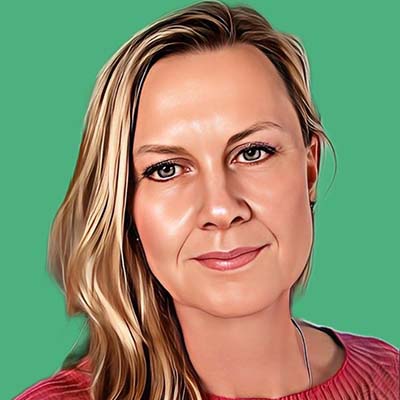

- Kristin Qvale
- Head of Cash Management Norway, BNP Paribas

- Lei Wang Giæver
- Treasurer, Crayon
Crayon’s Journey to Build a Dream Treasury House
In a rapidly growing company, cash visibility is paramount. Lei Wang Giæver, Treasurer, Crayon, together with Kristin Qvale, Head of Cash Management Norway, BNP Paribas, describes the “magical” process of creating a new treasury department that works closely with the business and finance teams within the global IT consultancy.
In creating a treasury team at Oslo-based Crayon, the company’s treasurer, Lei Wang Giæver, approached the task in the same way as a building project: renovating a house from the early 20th century that had “some issues”.
“It was like a mansion that looked nice on the outside but had areas needing attention when I walked inside; issues that required renovation,” she recalls. “There was a clear need to better champion treasury and how it related to, and could enhance, the overall business.”
After spending 30 months building out her treasury team, Giæver is happy with the journey and describes Crayon’s treasury as collaborative and able to support the company as it grows.
“These days I would say that the house has heating, hot water and electricity. Which is a great start. But there is always room for improvement,” she says.
Some of the remaining challenges are related to governance and ensuring that the Group treasury policy is well adapted and effective throughout operations within Crayon, as well as creating clear guidelines that can be improved and expanded over time.
“There’s a strong priority now on work on the finance side, which involves a huge amount of strategic planning. While at the beginning of our renovation we could take a piece-by-piece approach, we now have to tackle some issues in parallel and some sequentially.”
This is because the group is growing quickly – in May, the company reported Q1 results with gross profit growth of 17% and adjusted EBITDA at NOK203m, corresponding to a margin of 14%. The company says its growth is fuelled by businesses expanding their IT portfolios to prepare for Generative AI (GenAI). Crayon provides the software for security and productivity requirements to support this.
Feel the fear and do it anyway
For many companies, completing a treasury project within one or two years is acceptable, notes Giæver, but at Crayon, rapid growth means projects must be completed within six to nine months. “We are used to pushing ourselves in a company like this, and to be honest, in the beginning it was really scary for me,” she says.
Head of Cash Management Norway, BNP Paribas, Kristin Qvale, says the speed at which Crayon renovated its treasury department is impressive. “To be able to convince senior management of the value of treasury and of having a professional set-up, along with getting the necessary funding and hiring people to create such a team is the sort of thing we want to see from our clients,” she says.
While global banks such as BNP Paribas can provide cash management capability across multiple countries and global platforms for connectivity, global cash pooling, payment systems and onboarding platforms, “all of these systems and solutions don’t help if our clients don’t have the internal resources to take on these projects”, she points out.
The bank worked closely with Giæver and her team to create a structure that provided liquidity visibility and cash concentration, along with efficiency in reconciliation and payment processing. “In many companies, the treasury or cash management teams can be very small and there is a need for close collaboration, not only with internal teams, but also with external partners such as banks,” says Qvale. “We established a centralised implementation project team together with Crayon, with a project manager coordinating all the topics across countries. Our project managers have significant and relevant cash management knowledge, and we worked closely with Crayon to smooth the process and meet the expected timeline for go live.”
Strong bonds
An important element in the success of Giæver’s work at Crayon was a close working relationship with the company’s CFO. She says the CFO took a “very pragmatic” approach towards what was needed. “I could reach out to the CFO and say, ‘Hey, I think we need this’ and he’d encourage me to speak to the middle management team and clearly state my requirements and bring more people to an understanding of what the treasury was all about,” she says.
In general, the company was open to Giæver’s vision of what its treasury department should look like and “trusted me as a specialist”, she recalls. “I had the opportunity to put a forecasting solution in place as soon as I could. I also received support for many other solutions and could mature our banking relationship. It was a great deal of responsibility.”
Looking back at her early days at Crayon, Giæver concedes there were some “overwhelming” aspects of how treasury was conducted, including a requirement that many of the straightforward transactions had to be approved by the board. “I had to say, ‘If you want the treasury to run smoothly and efficiently, we need a certain level of authority and autonomy’.”
When gross sales ‘peak like a rocket’
“I felt in executing these projects, it wasn’t only about putting things in place, it was also about sending a strong signal as to the new role of treasury in the company – and what we expected to be done from a treasury point of view,” says Giæver. “While we had a cash pool when I started at Crayon, for example, it wasn’t widely understood among the finance team. We had to demonstrate to them what the advantages of the new system would be. First you have to acknowledge how painful existing processes are for those who are using them.”
One of the most beneficial projects has been the automation of liquidity forecasting. “This has been really liberating for many parties within the company and also outside because we no longer need to send through spreadsheets and we no longer have to chase people.”
Giæver describes the system as not only enabling the treasury to forecast liquidity but also giving an understanding of the liquidity pattern of the company. “I don’t think people have taken into consideration how much growth and how much weight we are actually lifting in terms of dollars and cents. When you have a gross revenue that is peaking like a rocket, you have to know where the cash is at all times.”
For other companies that are struggling with liquidity management, Giæver advises that they first tackle liquidity visibility: “you need to know how liquidity moves and where the cash is”.
Another element in the renovation of Crayon’s treasury was to “break up the traditional way of collaboration between the finance and operations cells”, engaging earlier and ensuring any risks were addressed before reaching out to clients.
“We are not a company with a huge amount of physical assets and investments,” says Giæver. “We have a different type of structure and the most essential topic for us is cash liquidity. Working with BNP Paribas on cash concentration was really important – you need the right banking partner to push this.”
Removing the pain, offering great gains
One of the first steps BNP Paribas took to help Crayon to meet its objectives was to set up direct connectivity with its treasury management system, recalls Qvale. “That way, Lei had access to all her accounts. Following on from that, we set up a pan-European cash pooling solution. Access to cash is a really basic step towards centralisation. The cash pool platform can easily be expanded on a global level, that is, we can easily plug in additional currencies and countries.”
BNP Paribas’ cash intercompany solution has helped Crayon overcome what can be a “pain” for many large organisations, says Giæver. “How an organisation is structured has a direct impact on how well intercompany loans are managed. For fast-growing companies like Crayon, you need a strong organisational structure that can go from the local level up to group level. We can now take the same steps as more matured and larger corporations, implement automation and ensuring sufficient IT resources that can support us and understand the accounting issues that need to be addressed.”
Companies need to “trust the process”, she adds, and keep progressing “full steam ahead”.
Qvale notes that some treasurers spend a significant amount of their time handling intercompany loans. If a company has an automated process through a zero balance physical cash pool structure, this can be an important win in terms of efficiency. Moreover, it enables the treasury team to focus on more strategic topics.
Subsidiaries may be used to seeing their full cash balance on an ‘external’ bank account instead of an ‘internal’ bank account and some more decentralised organisations are hesitant to change. By explaining the benefits of having a physical cash pool with an automated intercompany lending and borrowing solution, Giæver gained management buy-in and reassured subsidiaries unfamiliar with such a structure that they would not lose ownership of their cash.
Giæver says some of the subsidiaries that used the cash pool had previous knowledge of the process. For those that didn’t, the compensating element was that they no longer had to worry about paying their sister companies out of their working capital cycles.
“As a treasury, we offered these subsidiaries the opportunity to automatically borrow from the group as a whole. They no longer needed to undertake complex manual processes.”
Going forward, Giæver has hinted the plan of where Crayon’s treasury is headed, including the establishment of a payment factory and an IHB. “I believe that to build your own bank within a company will help to strengthen and optimize the processes. It will relieve the finance team from carrying out intercompany settlement, remove errors and reduce the time spent on closing process. A great way to go.”



